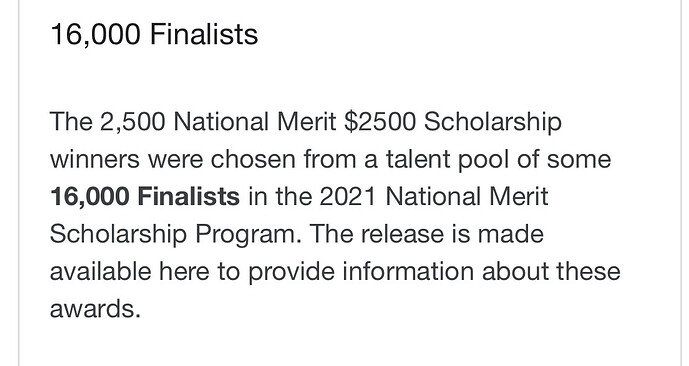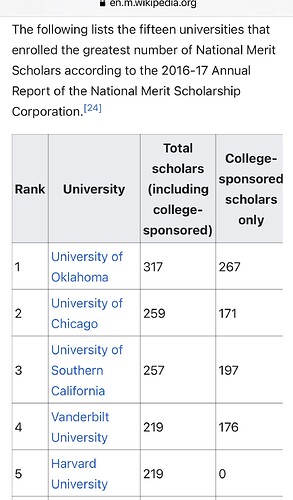342 Eckerd College
400+ outcomes
233 resources
223 engagement
400+ environment
$36,033 avg cost
It would be fun to see how many kids at each college pay those actual listed net prices, +- a couple thousand bucks.
Figure 50% are full pay and around 20% get a full ride. Of the remaining 30%, a big chunk will be donut-hole upper middle class families who receive a token amount of aid and lower-middle class families who have to pay only a token amount. There really aren’t many left to be paying that average number!
FWIW, per Harvard’s NPC, my kid would pay almost exactly that Net Price amount (within a few hundred dollars) to attend. The situation that generates this outcome: AGI $127k, typical or slightly less-than-typical assets for that level, modest college savings.
Forbes includes more of a cost analysis including debt and return on investment. The lower tuition state schools (especially UCs) tend to do better in Forbes ranking. Forbes Criteria
Here’s another link, Forbes Releases 2021 Top Colleges List Featuring New Methodology To Better Account For Which Schools Are Serving As True Engines Of The American Dream
So according to the article,
For the first time on Forbes’ Top Colleges ranking — and any major college ranking—a public school tops the list, besting all the Ivies—including Harvard. The University of California-Berkeley debuts in the top spot.
“The times demand a ranking that accounts for inclusivity, not exclusivity, and rewarding colleges and universities that are engines of the American Dream for the many and not a privileged few,” says Christian Kreznar , assistant editor at Forbes who led Top Colleges this year.
My apologies from yesterday @Data10, but if I were to guess, I would say that Forbes included College Scoreboard to the Payscale data based on the quote above, whatever its contribution may be. I don’t really peruse college rankings, but I would guess that before their 2021 ranking it was exclusively Payscale.
Bama does not accept 80% - they say - not sure who theywould turn down  but it’s in the 50s.
but it’s in the 50s.
Over 40% of their kids have a 30 ACT was the latest they put out.
They are getting Ivy kids.
My son was (as all seem to be) grade inflated big time in HS - with his 4.6 and 34 and is getting his a$$ handed to him at Bama and even withdrew from a class as my daughter just did at Charleston.
I don’t think these schools are grade inflated and I don’t, based on what I’m seeing, think the HSs are preparing these kids for the amount of work and pace of a college class.
According to the UAlabama 2020-2021 CDS:
39,560 applied
31,804 accepted
80% acceptance rate. Since last year was an anomaly, I looked at 2019-2020. Looks about the same (83%).
Exactly. It’s a game of musical chair between same schools for top 20 but top 100 varies a lot for different ranking criterions.
Middle 50% ACT is 23-31 at Alabama with a mean of 27.
At our HS, Alabama’s admissions rep compares UA with the other UA (Arkansas) that attracts a lot of students. Arkansas admits 78% of students with middle 50% ACT of 23-29 with mean of 26. With a similar admit rate, it appears Alabama is getting more top end students with a wider range.
These were the most up to date I could find…
My point was that UA may have a very small portion of their student population that has a super elite skill set and as a result those that do have such skills likely have an opportunity to shine against a more diluted pool then they would at a super elite school.
Sorry that your son had been challenged but I don’t think that either proves or disproves the initial question I asked unless you are saying he had declined acceptances at super elites and is now struggling at UA?
I have a spreadsheet ![]() . I started with
. I started with
EDIT: Found the follow ons, through 2022
And filled it in for years since. I can’t remember the last time I looked at it, or how recently I updated it - may have been when my older D graduated HS a few years back. (EDIT: Looks like the above were updated through 2022, so probably now more up to-to-date than I have.)
MIT had a page that tracked their many ranking over time, but I can’t seem to find it right now. I haven’t seen any others.
EDIT: Found it - Rankings — MIT Institutional Research
Who is “they” that say in the 50’s.
Their CDS, published by their own Office of Institutional Research and Assessment, says 80.4%
https://oira.ua.edu/new/reports/6064db264736214759aa9b0d#Common%20Data%20Set%202020-2021
Penn stands out. It was in the 19-20 range in the late '80s and then vaulted to 4-5 range in the early to mid '00s and now back down a bit.
The actual 20% that get rejected😀
Let me correct myself. Last year niche showed 57 or 56%. I always laughed at my son. Nothing wrong with Bama but I went to Syracuse so a little ribbing.
Now everything says 80%. I can’t find their official.
I think like any college. Engineering tough. Hospitality not 
They have 940 NMFs so lots of smart kids.
But so many great schools. So many.
Maybe my terminology is off. Here U go. 2nd paragraph
Don’t forget #35 Carleton College.
Makes more sense if we are not talking about NMF (finalists). The UA language seems odd so I would defer to others who are more expert.
I know there are about 50,000 kids a year that would qualify for the first round of NM recognition distinction. I suspect this is what is being referenced.
The way this award works is based on state by state performance. Consequently the required scores are significantly higher in states like NJ, VA, CA and MA. Alabama is 14th from the bottom.
It would not be surprising that a quality and popular state flagship like UA would retain in state a meaningful percentage of the 4,000 Alabama residents (4*1,000 per year) that received the “scholar” designation.
The more interesting analysis I think would be the percentage of that 940 that are from out of state and are they from statistically higher or lower NM scoring states. This would be representative of UA’s capacity to attract top tier academic students from outside of their local base.
I think it’s what it says. It’s legit. I saw a rank from 2017 and they were near the top. Of course they had a similar amount to Vandy but Vandy is a small fraction of the size.
I think Oklahoma is tops …it goes to show while of course some colleges are superior to others clearly most your large flagships have many Ivy caliber students. That’s why saying because you live in Nebraska so you attend Nebraska so you can get cheap tuition or live near home is dismissive. They have top level kids most everywhere
Freshman struggle mentally. I see it. I’d be more concerned to find a school with adequate mental health coverage, especially for first year. From what I see and hear from my kids’observations, it’s woefully inadequate.
I think more than rank ensuring your child has resources to support them is far more critical. Kids (and parents) act like the rankings thing is a game but the actuality is woefully different.
I assume, but don’t know, that the small private schools have much better mental health assets.
I don’t think so. This is the Wikipedia page you reference…
While you are correct that the info is dated the numbers remain a close proximity to what schools with the most enrolled NMF have and they are fractional to the 940 you and UA are citing. I suspect this is SF and “recognized” awards.



